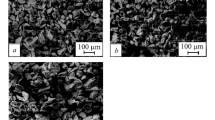Abstract
Modern noninvasive methods for probing the three-dimensional structure of materials, such as X-ray tomography, make it possible not only to obtain precise data on the structure of a sample but also to use them for assessing effective properties of the material by numerical methods. We have studied the pore structure of three samples of permeable porous ceramics by X-ray microtomography and numerically determined the permeability by solving the Stokes equation in the three-dimensional geometry of the pore structure. The data thus obtained are in excellent agreement with results of laboratory measurements. Morphological analysis of the pore structure (pore size distribution) allowed us to explain the results obtained for three samples of ceramics produced from granules of various sizes and shapes.
Similar content being viewed by others
References
Ohji, T. and Fukushima, M., Macro-porous ceramics: processing and properties, Int. Mater. Rev., 2012, vol. 57, no. 2, pp. 115–131.
Seculic, J., ten Elsho, J.E., and Blank, D.H.A., Selective pervaporation of water through a nonselective microporous titania membrane by a dynamically induce molecular sieving mechanism, Langmuir, 2005, vol. 21, no. 2, pp. 508–510.
Latella, B.A., Henkel, L., and Mehrteus, E.A., Permeability and high temperature strength of porous mullite–alumina ceramics for hot gas filtration, J. Mater. Sci., 2006, vol. 41, no. 2, pp. 423–430.
Staroverov, Yu.S. and Chernov, Yu.A., Application of ceramic foam filters in foundry and steelmaking, Ogneupory, 1992, no. 2, pp. 38–41.
Antonova, A.A., Zhilina, O.V., Kagramanov, G.G., and Nazarov, V.V., Catalytic active membranes on cerium dioxide basis, 6th Int. Conf. on Inorganic Membranes, Montpellier, 2000.
Polyakov, S.A. and Vel’mozhin, S.A., Ceramic diaphragm for electrolytic processes, Steklo Keram., 1989, no. 11, pp. 23–24.
Barinov, S.M. and Komlev, V.S., Biokeramika na osnove fosfatov kal’tsiya (Calcium Phosphate-Based Bioceramics), Moscow: Nauka, 2005.
Torquato, S., Random Heterogeneous Materials: Microstructure and Macroscopic Properties, New-York: Springer, 2002.
Petrasch, J., Meier, F., Friess, H., and Steinfeld, A., Tomography based determination of permeability, Dupuit–Forchheimer coefficient, and interfacial heat transfer coefficient in reticulate porous ceramics, Int. J. Heat Fluid Flow, 2008, vol. 29, pp. 315–326.
Blunt, M.J., Bijeljic, B., Dong, H., Gharbi, O., Iglauer, S., Mostaghimi, P., Paluszny, A., and Pentland, C., Porescale imaging and modeling, Adv. Water Resour., 2013, vol. 51, pp. 197–216.
Yeong, C.L.Y. and Torquato, S., Reconstructing random media. II. Three dimensional media from two dimensional cuts, Phys. Rev. E: Stat. Phys., Plasmas, Fluids, Relat. Interdiscip. Top., 1998, vol. 58, pp. 224–233.
Gerke, K.M., Karsanina, M.V., and Skvortsova, E.B., Description and reconstruction of the soil pore space using correlation functions, Eurasian Soil Sci., 2012, vol. 45, no. 9, pp. 861–872.
Gerke, K.M., Karsanina, M.V., Vasilyev, R.V., and Mallants, D., Improving pattern reconstruction using directional correlation functions, Europhys. Lett., 2014, vol. 106, p. 66002.
Salvo, L., Suery, M., Marmottant, A., Limodin, N., and Bernard, D., 3D imaging in material science: application of X-ray tomography, C. R. Phys., 2010, vol. 11, pp. 641–649.
Joos, J., Carraro, Th., Weber, A., and Ivers-Tiffee, E., Reconstruction of porous electrodes by FIB/SEM for detailed microstructure modeling, J. Power Sources, 2011, vol. 196, pp. 7302–7307.
Korost, D.V., Kalmykov, G.A., Yapaskurt, V.O., and Ivanov, M.K., Application of computed microtomography in studies of the structure of terrigenous collectors, Geol. Nefti Gaza, 2010, pp. 36–42.
Silin, D. and Patzek, T., Pore space morphology analysis using maximal inscribed spheres, Phys. A (Amsterdam, Neth.), 2006, vol. 371, pp. 336–360.
Dong, H. and Blunt, M.J., Pore-network extraction from micro-computerized-tomography images, Phys. Rev. E: Stat. Phys., Plasmas, Fluids, Relat. Interdiscip. Top., 2009, vol. 80, paper 036 307.
Author information
Authors and Affiliations
Corresponding author
Additional information
Original Russian Text © K.M. Gerke, D.V. Korost, R.V. Vasilyev, M.V. Karsanina, V.P. Tarasovskii, 2015, published in Neorganicheskie Materialy, 2015, Vol. 51, No. 9, pp. 1032–1038.
Rights and permissions
About this article
Cite this article
Gerke, K.M., Korost, D.V., Vasilyev, R.V. et al. Studying structure and determining permeability of materials based on X-Ray microtomography data (using porous ceramics as an example). Inorg Mater 51, 951–957 (2015). https://doi.org/10.1134/S002016851509006X
Received:
Published:
Issue Date:
DOI: https://doi.org/10.1134/S002016851509006X




